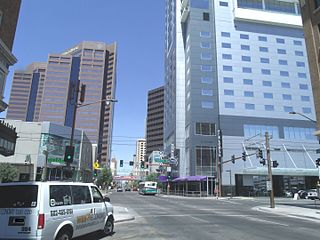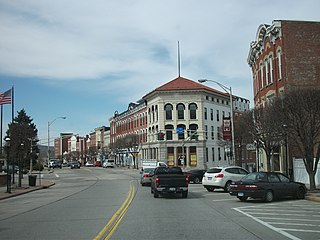
Downtown Pittsburgh, colloquially referred to as the Golden Triangle, and officially the Central Business District, is the urban downtown center of Pittsburgh, Pennsylvania, United States. It is located at the confluence of the Allegheny River and the Monongahela River whose joining forms the Ohio River. The triangle is bounded by the two rivers.

Downtown Phoenix is the central business district (CBD) of the City of Phoenix, Arizona, United States. It is in the heart of the Phoenix metropolitan area or Valley of the Sun. Phoenix, being the county seat of Maricopa County and the capital of Arizona, serves as the center of politics, justice and government on the local, state and federal levels. The area is a major center of employment for the region, with many financial, legal, and other national and international corporations housed in a variety of skyscrapers. Major arts and cultural institutions also call the area home. Downtown Phoenix is a center of major league sports activities, live concert events, and is an equally prominent center of banking and finance in Arizona. Regional headquarters for several major banks, including JP Morgan Chase, Wells Fargo, US Bank, Bank of America, Compass Bank and Midfirst Bank are all located within or close proximity to the area.

The Mexican War Streets, originally known as the "Buena Vista Tract," is an historic district that is located in the Central Northside neighborhood of Pittsburgh, Pennsylvania, in the United States. The district is densely filled with restored row houses, community gardens, and tree-lined streets and alleyways. The area dates to around the time of the Mexican–American War.

The Downtown Miami Historic District is a U.S. historic district located in the Central Business District of Downtown Miami, Florida.

The Gateway Center is a complex of office, residential, and hotel buildings covering 25 acres (10 ha) in Downtown Pittsburgh, Pennsylvania. It lies between Commonwealth Place and Stanwix Street at the western edge of the central business district, immediately to the east of Point State Park. Construction of the Gateway Center was one of the earliest urban renewal projects in the United States and part of Pittsburgh's Renaissance I programs which reshaped large sections of the city. The project was developed by the Equitable Life Assurance Society and built between 1950 and 1969.

The Greensburg Downtown Historic District of Greensburg, Pennsylvania, is bounded approximately by Tunnel Street, Main Street, Third Street, and Harrison Avenue. It consists of 62 buildings on 21.8 acres (8.8 ha), with the most notable buildings from the years 1872-1930. The district's oldest structure (1872) is the former Masonic Temple at 132 South Main Street. The Academy Hill Historic District is directly to the north of downtown Greensburg.

The Central Avenue Corridor is a significant stretch of north–south Central Avenue in Phoenix, Arizona. Roughly bounded by Camelback Road to its north, and McDowell Road to its south, this is one of Phoenix's most vital and heavily trafficked stretches of roads. It is also one of the region's largest centers of employment, with nearly 60,000 people being employed within a three-mile (5 km) radius of this swath of Central Avenue. Major employers here include major banks and financial institutions, hi-tech companies, and several significant law firms and government agencies.

The Central Troy Historic District is an irregularly shaped, 96-acre (39 ha) area of downtown Troy, New York, United States. It has been described as "one of the most perfectly preserved 19th-century downtowns in the [country]" with nearly 700 properties in a variety of architectural styles from the early 19th to mid-20th centuries. These include most of Russell Sage College, one of two privately owned urban parks in New York, and two National Historic Landmarks. Visitors ranging from the Duke de la Rochefoucauld to Philip Johnson have praised aspects of it. Martin Scorsese used parts of downtown Troy as a stand-in for 19th-century Manhattan in The Age of Innocence.

The Fort Madison Downtown Commercial Historic District has a collection of late-19th century store fronts centered on Ave. G, from 6th to 9th Street, and Ave. H from 7th to 9th, in Fort Madison, Iowa. It was listed on the National Register of Historic Places in 2007.

The Downtown Albany Historic District is a 19-block, 66.6-acre (27.0 ha) area of Albany, New York, United States, centered on the junction of State and North and South Pearl streets. It is the oldest settled area of the city, originally planned and settled in the 17th century, and the nucleus of its later development and expansion. In 1980 it was designated a historic district by the city and then listed on the National Register of Historic Places.

The Downtown Ossining Historic District is located at the central crossroads of Ossining, New York, United States, and the village's traditional business district known as the Crescent. Among its many late 19th- and early 20th-century commercial buildings are many of the village's major landmarks—three bank buildings, four churches, its village hall, former post office and high school. It was recognized as a historic district in 1989 and listed on the National Register of Historic Places, as one of the few downtowns in Westchester County with its social and historical development intact.

The Fourth Avenue Historic District is a historic district in downtown Pittsburgh, Pennsylvania, United States. The district was the center of finance and banks for the city during the decades surrounding the turn of the 20th century. Many ornate structures still exist from that era, including the location of the Pittsburgh Stock Exchange on the corner of Fourth Avenue and Smithfield Street from 1864 to 1903, the now vacant lot of its location at 229 Fourth Avenue from 1903 to 1962 and the still standing structure of the Exchange from 1962 until it closed in 1974. It is roughly bounded by Smithfield Street, Third Avenue, Market Square Place, and Fifth Avenue. The period of significance for the District is from 1871 to 1934.

Downtown Altoona Historic District is a national historic district located at Altoona, Blair County, Pennsylvania. The district includes 240 contributing buildings in the central business district and surrounding residential areas of Altoona. The buildings were primarily built after about 1860 and include residential, civic, social, and religious buildings. Although it does not encompass the entire downtown, it is for the most part the most urban part of Altoona's downtown district. Notable buildings include the Cathedral of the Blessed Sacrament (1920s), First Methodist Episcopal Church, First Presbyterian Church, First Evangelical Lutheran Church (1896-1897), U.S. Post Office (1931-1933), Fraternal Order of Eagles Building (demolished), Altoona City Hall, Casanave Building (1890s), Hutchison Block, McCrory's Department Store (1937), and Aaron-Penn Furniture Building. Located in the district are the separately listed Central Trust Company Buildings, Mishler Theatre, and Penn Alto Hotel.
The numerous historic hotels in Meridian, Mississippi, provide insights into the city's growth and expansion, both in the late 19th and early 20th centuries and into the modern age. Many hotels were built in downtown Meridian in the early 1900s to provide lodging for passengers of the railroad, which was essential to the city's growth at the turn of the 20th century. Two of these historic hotels–the Union Hotel, built in 1910, and the Lamar Hotel, built in 1927–have been listed on the National Register of Historic Places.
Grant Street is the main government and business corridor in Pittsburgh, Pennsylvania. It is home to the global headquarters of U.S. Steel, Koppers Chemicals, and Oxford Development. It also is home to the seat of Allegheny County, City of Pittsburgh and the regional Federal Government offices. It is part of the Pittsburgh Central Downtown Historic District.

The Pittsburgh Renaissance Historic District is a historic district in the Central Business District of Pittsburgh, Pennsylvania, United States. It was listed on the National Register of Historic Places on May 2, 2013.

The Downtown Cheyenne Historic District in Cheyenne, Wyoming is a historic district that was listed on the National Register of Historic Places in 1978. It is an area of about seven blocks, in the core of the original business district of Cheyenne, and home of many of the first masonry commercial buildings in Cheyenne.

The Hendel Building, more commonly known as the Skinny Building, is an unusual building in Downtown Pittsburgh, Pennsylvania. At only 5 feet 2 inches (1.57 m) wide, it is one of the narrowest commercial buildings in the world, rivaling the Sam Kee Building in Vancouver which is considered the narrowest by Guinness World Records. The Kee building is 4 feet 11 inches (1.50 m) wide at the ground floor, but has overhanging bay windows on the second floor that extend to 6 feet (1.8 m). The Skinny Building's narrow lot was created in 1903 by a street widening project, and the building itself was constructed in 1926 by Louis Hendel, partly out of spite for neighboring business owners who complained about him obstructing the sidewalk with his fruit-selling business. Due to the building's impractical dimensions, the second and third floors have not seen much use, but the ground floor has housed a number of different businesses including a popular lunch counter. It is listed on the National Register of Historic Places as a contributing property in the Fourth Avenue Historic District.

The Frank & Seder Building is a 30-metre (98 ft), 7-story, former department store building completed in 1918 on Smithfield Avenue in downtown Pittsburgh, Pennsylvania, United States. The building is a contributing structure in the Pittsburgh Central Downtown Historic District.



















